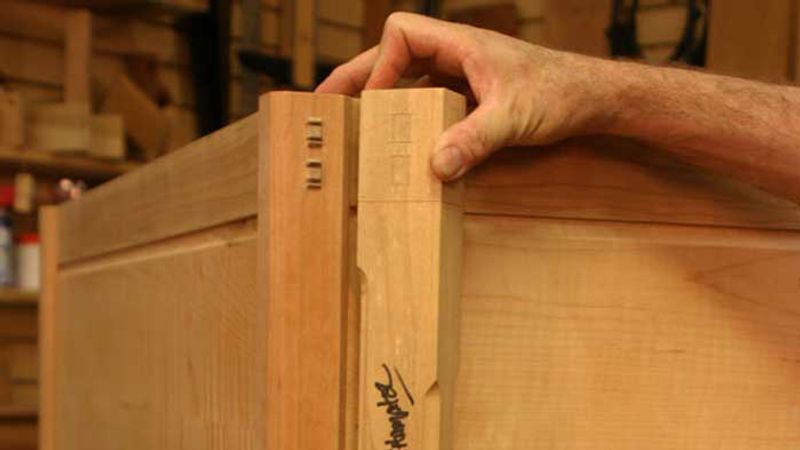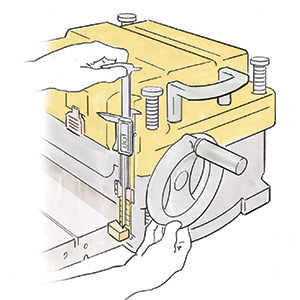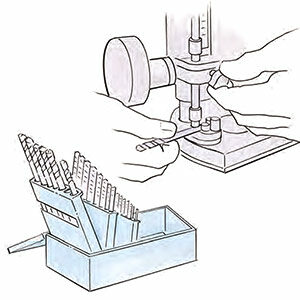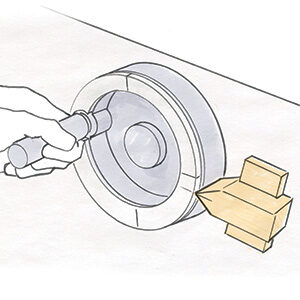Story Stick for Accurate, Repeatable Cuts
Learn how to use a story stick to accurately repeat cuts and map out joinery for an entire project on one piece of wood. Measure once and cut 100 times!
Sometimes it’s easier, and even more accurate, to toss away your tape measure when laying out joinery for a furniture project. A wobbly tang on the end of a tape, tiny and sometimes difficult-to-read tick marks on a scale, and even fat pencil leads can lead to joints that miss the mark ever-so-slightly.
Learning how to use a story stick will help you avoid measurement errors and ensure precision repeatability when cutting furniture parts. In many cases, you can almost toss away your printed plans and layout an entire piece of furniture – joinery and all – on a single piece of wood containing all the measurements necessary to bring your piece to life.
It’s all about learning to measure from reality.






















Comments
Thanks Bob, that was very informative. Story sticks makes lots of sense. I’ll put those into practice from now on.
10 years ago and still holds true thanks Man
As usual, interesting and helpful. Thank you.
But as a UK user, with European attitudes to safety, I'm appalled to see a demo using a table saw with NO safety guards. I've often seen this in US-origin videos, and while it is sometimes justified by an explanation that 'we wanted to enable viewers to see more clearly....' that doesn't seem to be the case here.
Are safety guards not a legal requirement in North America (particularly USA)? And even if they aren't, shouldn't Fine Woodworking be showing best practice? This isn't the first video I've seen with no safety guards in place.
Very good advice and explanation Bob. This is one of those things, once you see it you wonder how you got along without it. I'll be making lots less mistakes now after learning this technique for accuracy.
Great tips from Bob, as usual.
And in regards to JohnWMcC's comments on lack of safety guards, I have come to work without them, also. The tablesaw is the most dangerous tool in my shop. The manufacturers all insist that the sawguard remain in place, but despite my best efforts, I have never been able to figure out how to use this or other guards in ways that allow me to see and manipulate the board and the cutting process in a safer fashion than without the guard. I have investigated and tried a variety of aftermarket and self-made modifications, but keep coming back to leaving my guard on the shelf.
Instead, I always always approach my tablesaw with great respect and a degree of justified fear. I use a riving knife, survey my setup before starting, am acutely sensitive to any unusual sound or feel as the board enters the blade, and most importantly, use a routine---every time---that involves stopping before and after each cut to assess the operation for hazards. It starts before I press the power button and I do not relax until the sawblade comes to a stop. Before I start, I also ask two questions: am I feeling impatient with a repetitious process, and/or am I feeling at all rushed. If so, I stop and ask if I need to walk away and come back later.
And as I get more experience, I continue to remind myself that skill and experience do not immunize me from losing fingers if I relax my vigilance or safety routines.
I agree, I rarely use the blade guard on my tablesaw because it always seems to be in the way. The prawls cut into my wood and often jam the wood against the spinning blade. At times the plastic guard gets pushed against the blade so now I can't see through that side of the guard. At times when I'm measuring from the blade tooth to the fence the guard slams down on my finger.
I will always use a riving knife and I would like to use the blade guard, but I just feel more confident without it. I keep several push sticks of varying sizes adjacent to the fence that I will use in all rip cuts and I never allow my hands to get near the spinning blade.
4 things.
1. Regarding the blade guard, I found the guard on my saw stop works very well I use it most of the time.
2. I noticed Bob rotates the board before each cut. Is this just to compensate for any minor deviation of the miter set up not being exactly square?
3. When transferring measurements with a pencil I always put the pencil on the mark and slide the straight edge up to it. That takes the eye ball pencil width out of the equation.
4. I use 2 in. adding machine tape for story sticks. I learned this working in kitchen cabinet shops. You can lay out a whole wall of cabinets that way with all the component pieces. After I'm done the tape rolls up small, I identify it and put it in the drawer. Does not take up as much room as a solid stick. Of course the stick lays flat with out any help, the tape likes to roll back up.
Safety: After I let my hand drift into my Makita power planer as it coasted down and removed a chunk of my middle finger, I started asking other woodworkers about accidents they had. Nearly every one I questioned said they were finished with the cut and were not focused on the tool after the wood had passed the spinning blades. Others said they were thinking about something other than what they were doing and they got careless. Now, I also pause like, Tbone Tim, before I start any machining and review the action I am about to attempt. I usually ask myself bluntly, "How am I going to F*#% this up?" I don't want to clean up any more blood from my tools!
I used to attempt to use blade guards, but there are so many table saw maneuvers which are impossible to achieve with these devices on. Dust collection from above the table surface is not thought through either with my standard blade guards. I do wish manufacturers would continue to develop better guards that are easier to re-install, easier to use and allow for dust collection.
I have a Powermatic PM66 that I purchased in 1988. The splitter/guard was quickly relegated to a shelf. After some time I installed an Excalibur overarm blade guard. The overarm dust collection didn't seem to pick up much so I stopped using the guard. A few months ago when ripping I stopped a kickback with my torso. It was my first and no blood! I modified my outfeed table to accommodate the PM guard. After 5 months I find that it takes only a few minutes to remove the guard for non-through cuts and no more to reinstall it so I use it.
On balance I think I was fortunate to suffer the kickback.
Log in or create an account to post a comment.
Sign up Log in